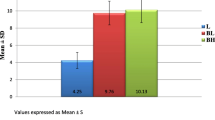Abstract
Introduction
This is a prospective, non-randomized, hospital-based, case-controlled, clinical trial to assess the efficacy of perineural infiltration with bupivacaine at the related neural root for acute pain relief after lumbar laminectomy.
Method
Fifty-one patients undergoing unilateral one spinal level (lumbar 4) hemi-partial laminectomy were included in the study. In 22 of the patients (Group 2), bupivacaine was infiltrated onto the neural root immediately after the exposure; the 29 patients in the control group (Group 1) were not infiltrated. All patients were monitored post-operatively regarding pain determination using a visual analog scale, and the exact time of analgesic requirement during the first post-operative day was noted. Total analgesic dose given during the first post-operative day was also recorded.
Results
The patients who received bupivacaine infiltration intraoperatively onto the neural root (Group 2) had a statistically significantly longer time to first analgesia request (P < 0.001) and also required significantly less analgesic when compared to the control group (Group 1) (P < 0.001). Perineural bupivacaine infiltration extended the early post-operative analgesic period. While the pain was not completely suppressed, the bupivacaine infiltration helped to manage the post-operative pain more effectively.
Conclusion
Our data suggests that pre-emptive analgesia via perineural infiltration of bupivacaine is a simple, and effective method for post-operative acute pain relief.
Similar content being viewed by others
References
Butterworth JF IV, Strichartz GR (1990) Molecular mechanisms of local anesthesia: a review. Anesthesiology 72:711–734
Chen C, Cavanaugh JM, Song Z et al (2004) Effects of nucleus pulposus on nerve root neural activity, mechanosensitivity, axonal morphology, and sodium channel expression. Spine 29:17–25
Cherian MN, Mathews MP, Chandy MJ (1997) Local wound infiltration with bupivacaine in lumbar laminectomy. Surg Neurol 47:120–123
Dobromylskyj P, Flecknell PA, Lascelles BD (2000) Management of postoperative and other acute pain. In: Flecknell PA, Waterman PA et al (eds) Pain management in animals. WB Saunders, London, pp 81–145
Ersayli DT, Gurbet A, Bekar A et al (2006) Effects of perioperatively administered bupivacaine and bupivacaine-methylprednisolone on pain after lumbar discectomy. Spine 31:2221–2226
Glasser RS, Knego RS, Delashaw JB et al (1993) The perioperative use of corticosteroids and bupivacaine in the management of lumbar disc disease. J Neurosurg 78:383–387
Gurbet A, Bekar A, Bilgin H et al (2008) Pre-emptive infiltration of levobupivacaine is superior to at-closure administration in lumbar laminectomy patients. Eur Spine J 17:1237–1241
Gust R, Pecher S, Gust A et al (1999) Effect of patient-controlled analgesia on pulmonary complications after coronary artery bypass grafting. Crit Care Med 27:2218–2223
Jayr C, Mollié A, Bourgain JL et al (1998) Postoperative pulmonary complications: general anesthesia with postoperative parenteral morphine compared with epidural analgesia. Surgery 104:57–63
Johnson RG, Miller M, Murphy M (1989) Intraspinal narcotic analgesia. A comparison of two methods of postoperative pain relief. Spine 14:363–366
Kalkan E, Torun F, Tavlan A et al (2008) The effect of meperidine-impregnated autogenous free fat grafts on postoperative pain management in lumbar disc surgery. J Spinal Disord Tech 21:92–95
Kaye AD, Baluch A, Kaye AJ et al (2008) Pharmacology of cyclooxygenase-2 inhibitors and preemptive analgesia in acute pain management. Curr Opin Anaesthesiol 21:439–445
Kehlet H (1999) Acute pain control and accelerated postoperative surgical recovery. Surg Clin North Am 79:431–443
Kundra P, Gurnani A, Bhattacharya A (1997) Preemptive epidural morphine for postoperative pain relief after lumbar laminectomy. Anesth Analg 85:135–138
Milligan KR, Macafee AL, Fogarty DJ et al (1993) Intraoperative bupivacaine diminishes pain after lumbar discectomy. A randomised double-blind study. J Bone Joint Surg Br 75:769–771
Møiniche S, Kehlet H, Dahl JB et al (2002) A qualitative and quantitative systematic review of preemptive analgesia for postoperative pain relief: the role of timing of analgesia. Anesthesiology 96:725–741
Ong CK, Lirk P, Seymour RA et al (2005) The efficacy of preemptive analgesia for acute postoperative pain management: a meta-analysis. Anesth Analg 100:757–773
Ready LB (1994) Acute postoperative pain. In: Bonica JJ (ed) Anesthesia, vol I. Churchill Livingstone, New York, pp 2327–2335
Rosenberg J, Kehlet H (1999) Does effective postoperative pain management influence surgical morbidity? Eur Surg Res 31:133–137
Schofferman J, Reynolds J, Herzog R et al (2003) Failed back surgery: etiology and diagnostic evaluation. Spine J 3:400–403
Sekar C, Rajasekaran S, Kannan R et al (2004) Preemptive analgesia for postoperative pain relief in lumbosacral spine surgeries: a randomized controlled trial. Spine J 4:261–264
Shipton E (2008) Post-surgical neuropathic pain. ANZ J Surg 78:548–555
Toyone T, Tanaka T, Kato D et al (2004) Low-back pain following surgery for lumbar disc herniation. A prospective study. J Bone Joint Surg Am 86:893–896
Weinstein JN, Tosteson TD, Lurie JD et al (2006) Surgical vs nonoperative treatment for lumbar disk herniation: the Spine Patient Outcomes Research Trial (SPORT): a randomized trial. JAMA 296:2441–2450
Author information
Authors and Affiliations
Corresponding author
Rights and permissions
About this article
Cite this article
Mordeniz, C., Torun, F., Soran, A.F. et al. The effects of pre-emptive analgesia with bupivacaine on acute post-laminectomy pain. Arch Orthop Trauma Surg 130, 205–208 (2010). https://doi.org/10.1007/s00402-009-0961-2
Received:
Published:
Issue Date:
DOI: https://doi.org/10.1007/s00402-009-0961-2




